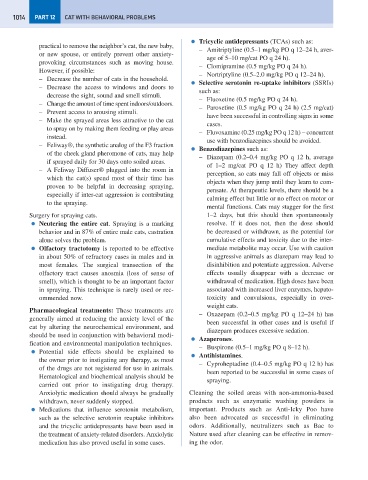Page 1022 - Problem-Based Feline Medicine
P. 1022
1014 PART 12 CAT WITH BEHAVIORAL PROBLEMS
● Tricyclic antidepressants (TCAs) such as:
practical to remove the neighbor’s cat, the new baby,
– Amitriptyline (0.5–1 mg/kg PO q 12–24 h, aver-
or new spouse, or entirely prevent other anxiety-
age of 5–10 mg/cat PO q 24 h).
provoking circumstances such as moving house.
– Clomipramine (0.5 mg/kg PO q 24 h).
However, if possible:
– Nortriptyline (0.5–2.0 mg/kg PO q 12–24 h).
– Decrease the number of cats in the household.
● Selective serotonin re-uptake inhibitors (SSRIs)
– Decrease the access to windows and doors to
such as:
decrease the sight, sound and smell stimuli.
– Fluoxetine (0.5 mg/kg PO q 24 h).
– Change the amount of time spent indoors/outdoors.
– Paroxetine (0.5 mg/kg PO q 24 h) (2.5 mg/cat)
– Prevent access to arousing stimuli.
have been successful in controlling signs in some
– Make the sprayed areas less attractive to the cat
cases.
to spray on by making them feeding or play areas
– Fluvoxamine (0.25 mg/kg PO q 12 h) – concurrent
instead.
use with benzodiazepines should be avoided.
– Feliway®, the synthetic analog of the F3 fraction
● Benzodiazepines such as:
of the cheek gland pheromone of cats, may help
– Diazepam (0.2–0.4 mg/kg PO q 12 h, average
if sprayed daily for 30 days onto soiled areas.
of 1–2 mg/cat PO q 12 h) They affect depth
– A Feliway Diffuser® plugged into the room in
perception, so cats may fall off objects or miss
which the cat(s) spend most of their time has
objects when they jump until they learn to com-
proven to be helpful in decreasing spraying,
pensate. At therapeutic levels, there should be a
especially if inter-cat aggression is contributing
calming effect but little or no effect on motor or
to the spraying.
mental functions. Cats may stagger for the first
Surgery for spraying cats. 1–2 days, but this should then spontaneously
● Neutering the entire cat. Spraying is a marking resolve. If it does not, then the dose should
behavior and in 87% of entire male cats, castration be decreased or withdrawn, as the potential for
alone solves the problem. cumulative effects and toxicity due to the inter-
● Olfactory tractotomy is reported to be effective mediate metabolite may occur. Use with caution
in about 50% of refractory cases in males and in in aggressive animals as diazepam may lead to
most females. The surgical transection of the disinhibition and potentiate aggression. Adverse
olfactory tract causes anosmia (loss of sense of effects usually disappear with a decrease or
smell), which is thought to be an important factor withdrawal of medication. High doses have been
in spraying. This technique is rarely used or rec- associated with increased liver enzymes, hepato-
ommended now. toxicity and convulsions, especially in over-
weight cats.
Pharmacological treatments: These treatments are
– Oxazepam (0.2–0.5 mg/kg PO q 12–24 h) has
generally aimed at reducing the anxiety level of the
been successful in other cases and is useful if
cat by altering the neurochemical environment, and
diazepam produces excessive sedation.
should be used in conjunction with behavioral modi-
● Azaperones.
fication and environmental manipulation techniques.
– Buspirone (0.5–1 mg/kg PO q 8–12 h).
● Potential side effects should be explained to
● Antihistamines.
the owner prior to instigating any therapy, as most
– Cyproheptadine (0.4–0.5 mg/kg PO q 12 h) has
of the drugs are not registered for use in animals.
been reported to be successful in some cases of
Hematological and biochemical analysis should be
spraying.
carried out prior to instigating drug therapy.
Anxiolytic medication should always be gradually Cleaning the soiled areas with non-ammonia-based
withdrawn, never suddenly stopped. products such as enzymatic washing powders is
● Medications that influence serotonin metabolism, important. Products such as Anti-Icky Poo have
such as the selective serotonin reuptake inhibitors also been advocated as successful in eliminating
and the tricyclic antidepressants have been used in odors. Additionally, neutralizers such as Bac to
the treatment of anxiety-related disorders. Anxiolytic Nature used after cleaning can be effective in remov-
medication has also proved useful in some cases. ing the odor.

